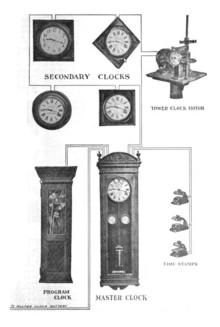Slave clock
This article has multiple issues. Please help improve it or discuss these issues on the talk page. (Learn how and when to remove these messages)
|
In telecommunication and horology, a slave clock is a clock that depends for its accuracy on another clock, a master clock. Many modern clocks are synchronized, either through the Internet or by radio time signals, to a worldwide time standard called Coordinated Universal Time (UTC) based on a network of master atomic clocks in many countries. For scientific purposes, precision clocks can be synchronized to within a few nanoseconds by dedicated satellite channels. Slave clock synchronization is usually achieved by phase-locking the slave clock signal to a signal received from the master clock. To adjust for the transit time of the signal from the master clock to the slave clock, the phase of the slave clock may be adjusted with respect to the signal from the master clock so that both clocks are in phase. Thus, the time markers of both clocks, at the output of the clocks, occur simultaneously.[1]
Before the computer era, the term referred to satellite electrical clocks that are synchronized periodically by an electrical pulse issued by a master clock. From the late 19th to the mid 20th centuries, electrical master/slave clock systems were widely used in public buildings and business offices, with all the clocks in the building synchronized through electric wires to a central master clock.
These older styles of slave clocks either keep time by themselves, and are periodically corrected by the master clock, or require impulses from the master clock to advance. Many slave clocks of these types remain in operation, most commonly in schools.

Pictures
Mechanical slave clocks from the 1950s and 1960s era.
-
Slave clock
-
Synchronome slave clock
-
Early G.P.O. type 6, manufactured by Synchronome
-
Slave clock drive mechanism
-
A slave clock driven by a quartz clock module.
References
- ^
 This article incorporates public domain material from Federal Standard 1037C. General Services Administration. Archived from the original on 2022-01-22.
This article incorporates public domain material from Federal Standard 1037C. General Services Administration. Archived from the original on 2022-01-22.





